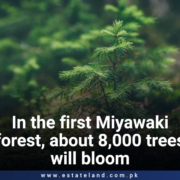The urban forest of Jauharabad is poised to become a trailblazer
The urban forest of Jauharabad is poised to become a trailblazer. By designating the Miyawaki forest established in Jauharabad town near Khushab as a’model forest,’ the Ministry of Climate Change (MOCC) has advocated installing similar initiatives along the motorway and in the surrounding areas of Multan.
According to Forest Department SDO Abdul Ghaffar, Japanese scientist Akira Miyawaki pioneered urban forest planting in 1970. Using this technology can plant forests on land ranging from one marla to a few acres in cities. They supported the concept in light of trees’ role as “the earth’s lungs.”
Pakistan has also adopted the concept, with the forest service establishing a model forest on five kanals of land in the Khushab district. The official stated that Miyawaki woods in cities might help clean up and improve the environment by reducing greenhouse gases and other pollutants in the water, air, and land.
“The area is deeply excavated, and the soil is amended with various local nutrients and fertilizers, including nitrogen, phosphorus, and potassium. Finally, a forest department employee explained that the site is leveled and then planted with huge trees, shrubs, herbs, and grass,” a forest department employee explained.
Read more with EL news : In the first Miyawaki forest, about 8,000 trees will bloom
Certain types of trees are kept apart, while compatible ones are planted closer together and given extra care, he explained. “Jauharabad is being marketed as a Miyawaki forest model because it was grown using the traditional Japanese method.” The forest received a total of Rs612,000 in three years, he stated, which is a pittance compared to its importance and utility.
District Forest Officer Naseem Iqbal Butt stated that the Miyawaki approach results in a tenfold increase in tree cover compared to natural forests. “These forests are far denser than genuine jungles.” He stated that urban forestry aids in the elimination of pollutants in densely populated regions and contributes to the creation of beauty and a pleasant environment.
“Approximately 25 tree and plant species have been planted in Joharabad’s Miyawaki forest, including Sahanjana, Behera, Sukh Chain, Palkan, Sheesham, Darikh, Bacain Bottle Brush, Table Palm, Kachnar, Jaman, Pipal, Phatix, Kakar, Santha, Mulberry, Mara, Motiya, Gulab, Amaltas, and Neem. Similar trees have been planted, and the spacing between them follows the Miyawaki method,” he explained.
“It took a great deal of effort on the part of our personnel to transform the Miyawaki forest in the Khushab forest department into a model forest, as declared by the federal ministry,” he explained.
Arshad Nadeem Malik, an arborist, commented on the initiatives, stating that they had delegated duty for the Miyawaki woodlands to the forest department by the Parks and Horticulture Authority (PHA). “The forest department in Khushab and the PHA in Sargodha have been assigned the project. It is because the forest department employs the most qualified personnel for tree planting.”
He stated that the forest department is investing approximately Rs700,000 per acre in the Miyawaki program, including protecting it. “According to reports, the PHA is spending Rs2.9 million per acre on a forest being cultivated using the Miyawaki method. The government should cede control of all forests to the forest service.”
According to Abdul Rehman, a resident, the Miyawaki plantation appeared to be the most effective way to improve the environment.
Keep up with Estate Land Marketing for news and updates.






Leave a Reply
Want to join the discussion?Feel free to contribute!